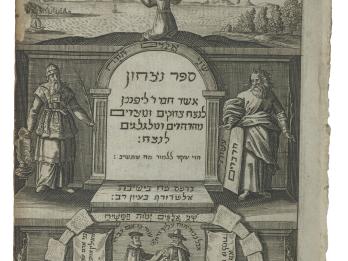Tosafot Yom Tov (The Additions of Yom Tov)
Yom Tov Lipmann Mühlhausen
Theodore Hackspan
Yom Tov Lipmann Heller
1614–1617
“Moses received the Torah from Sinai” [m. Avot 1:1]:
R. [Ovadiah] from Bartenura has explained this to mean “from the One revealed at Sinai.” And there, when God revealed Himself at Sinai, Moses received it in its general principles, its details and finer points, and did not innovate halakhah himself. And this is as the rabbis taught in Torat kohanim [Leviticus], cited by Rashi in his commentary to the beginning of the weekly portion Behar Sinai. It was in order to teach us this that it says: “from Sinai.” Nor is it an insignificant point, as this is a sign of the veracity of our religion. She is the only one of her mother, i.e., the Assembly of Israel who accepted it. She is the choice one of her that bore her—the disciples are the Almighty’s children [see Songs of Songs 6:9]—whatever a veteran student will present as a novelty was all already received by Moses, as it is stated: And upon the Tablets were according to all the words (Deuteronomy 9:10), etc., regarding which the sages expounded in b. Megillah 19b: “This teaches us that the Holy One showed Moses the finer points of the Torah and the finer points of the scribes.” And although the finer [i.e., stylistic, syntactical, and orthographic] points of the scribes served merely as testimony [to the Torah’s veracity], as I have explained in my introduction, this mishnah states: “he received them,” because this term is referring to most of the Torah. This is as Naḥmanides explains in the introduction to his Pentateuchal commentary concerning the fifty gates of understanding that were created in the world, i.e., that the phrase were created applies to most of them.
This appears to me to be the correct interpretation. “And transmitted it to Joshua” [m. Avot 1:1]:
Everything he had received, Moses transmitted to Joshua; but regarding Moses, it could not be said that “[the Torah] was transmitted to him,” since the entirety of the Torah was not transmitted to him, as the fiftieth gate was not delivered to him, as the sages of blessed memory have stated [see b. Rosh Hashanah 21b] in connection with [the biblical verse]: And You made him a little lower than the angels (Psalms 8:6). Hence it says about him that “he received” [the Torah], i.e., all that was appropriate for him to receive, he received from Sinai—thus have the commentators explained it.
“And the prophets transmitted it to the Men of the Great Assembly” [m. Avot 1:1]:
That is, although not all of the assembly were prophets, the entire Torah was transmitted to them, just as it had been to their predecessors; but henceforth, when the generations became spiritually weaker, it was not transmitted in its entirety, but rather, each individual received it in a measure commensurate with his spiritual strength. But at any rate, the Torah transmitted to him was received by him [as authentic tradition] handed down from one individual to another, all the way back to Moses our teacher from Sinai.
“The Great Assembly” [m. Avot 1:1]:
R. Bartenura stated that they were so called because they “restored the divine crown to its pristine glory,” etc. Jeremiah and Daniel came along and did not employ the epithets “mighty” and “awesome” [when describing God]. Jeremiah said (32:18): The great, mighty God, the Lord of hosts is His name, but did not say the awesome. Daniel said (9:4): The great and awesome [God], but did not say the mighty.
“They said three things” [m. Avot 1:1]:
R. Bartenura explained that these encapsulate the preservation of the Torah, and in m. Avot 2:10, he likewise explicates a similar expression as “a common idiom [of that sage],” as he does also regarding the phrase: “he used to say”—in m. Avot 1:2.
“And raise up disciples” [m. Avot 1:1]:
The sages here employed a word denoting “standing” (ha‘amidu) because [b. Megillah 21a]: “from the days of Moses to those of Rabban Gamaliel, they used to learn while standing” (as R. Bartenura explained at the end of m. Sotah 9:15), while the teacher would sit on a chair [see Midrash Samuel], cited in the name of R. Joseph Ibn Naḥmias. Now although this explanation is linguistically correct, it misses the real point of what is meant to be conveyed here, it being irrelevant whether the students would stand or sit; and moreover, why does our mishnah say: “And raise up” rather than “and teach,” which reflects the author’s true intention? Accordingly, it seems to me that when it says “And raise up disciples,” it means to get them to stand on their feet in such manner that they do not slip; namely, to set them on their feet in their comprehension of the truth of the Torah, which constitutes standing and preservation, as falsehood has no feet [see b.Shabbat 104a]; and this accords with the Psalmist’s words [73:2]: “My feet nearly slipped.”
And, since [the author of the Mishnah] wished to say “many disciples,” he needed to employ the expression “standing,” in that even if one’s disciples are numerous, the teaching should nonetheless be conducted so as to ensure that they will always be “standing” upon the truth—for without this element, there can be no authentic raising of disciples, but on the contrary, they become dreamers, lying in a deep sleep of folly. What emerges for us from these words, taken as a whole, is that we do not fulfill this ethical direction unless we teach truth and righteousness, and nothing besides. Note what I write on this subject below in my comments on m. Avot 1:6.
Credits
Published in: The Posen Library of Jewish Culture and Civilization, vol. 5.





